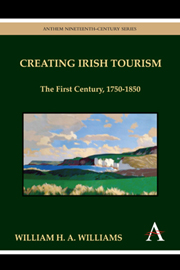Chapter 10 - The Famine and After
from Part III
Published online by Cambridge University Press: 05 March 2012
Summary
While Ritchie's and Fisher's conclusions may not be typical of those pursuing the picturesque tour in Ireland, most travel writers did at least take notice of Irish poverty and privation. But if social realities had the power to push their way through the conventions of the picturesque, the reverse is also strangely true. By the time of the Great Famine, the picturesque had so defined Ireland that even some of those who came to observe the crisis and/or to minister to its victims were drawn to Ireland's scenic landscapes. Although the number of “tourists” must have dropped during the Famine, roughly the same number of travel accounts appeared during the most critical years, 1846 and 1849, as had been published between 1840 and 1845, the year the potato blight first appeared.
Relatively few of the travel accounts produced during the Famine described what might be considered conventional picturesque tours. In what may be one of the first examples of “disaster tourism,” visitors from Britain came to Ireland during the worst years of the crisis to verify the extent of the problem or to provide relief. Touring during 1847, one of the worst years of the crisis, Rev. John East visited some of the hardest hit areas. An Evangelical who suspected that the Roman Catholic peasantry and their clerical leaders had brought the catastrophe upon themselves, East encountered and described some grim scenes. Yet, he also visited Killarney, Bantry Bay and other scenic locations, which he greatly appreciated.
- Type
- Chapter
- Information
- Creating Irish TourismThe First Century, 1750–1850, pp. 183 - 192Publisher: Anthem PressPrint publication year: 2010



